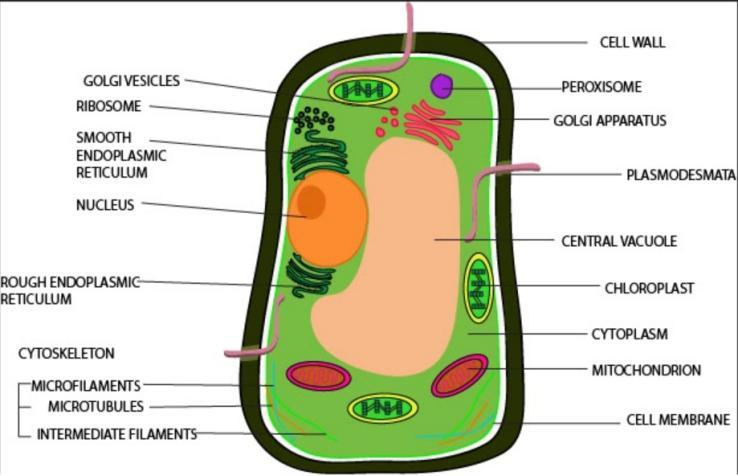
Answer
381k+ views
Hint: Plant cells are the primary and functional unit of plants. It is of different shapes, fit as a fiddle and bigger in size than an animal cell. Plants are autotrophic while animals are heterotrophic.
Complete step by step answer:

The diagram is of a plant cell and the primary parts which makes a plant cell unique in relation to animal cell are:
1) Chloroplast: Chloroplast contains chlorophyll and the interaction of photosynthesis takes place inside them.
2) Vacuole: Vacuole is a space inside the cytoplasm of a cell which contains liquid. It is encased by a membrane. It is encircled by tonoplast and the primary capacity is Storage and upkeep of the cell.
3) Cell Wall: The peripheral layer of cells in plants, microscopic organisms, growths, and numerous green growths that offers shape to the phone and shields it from disease is called a cell divider. It is made up generally of cellulose. It is the peripheral layer composed of proteins, cellulose, and polysaccharides. The primary capacity is to secure the cell and to offer underlying help to the cell. It additionally directs the development of atoms all through the cell.
Note:
Plant cell is rectangular with an enormous vacuole possessing $30\%$ of the cell. volume. It is limited by a cell divider and cell layer which is inward to the cell divider It has a core conveying the hereditary material and cell organelles, for example, mitochondria, lysosomes, ribosomes, Golgi apparatus, and so on with fluctuated capacities.
Complete step by step answer:

The diagram is of a plant cell and the primary parts which makes a plant cell unique in relation to animal cell are:
1) Chloroplast: Chloroplast contains chlorophyll and the interaction of photosynthesis takes place inside them.
2) Vacuole: Vacuole is a space inside the cytoplasm of a cell which contains liquid. It is encased by a membrane. It is encircled by tonoplast and the primary capacity is Storage and upkeep of the cell.
3) Cell Wall: The peripheral layer of cells in plants, microscopic organisms, growths, and numerous green growths that offers shape to the phone and shields it from disease is called a cell divider. It is made up generally of cellulose. It is the peripheral layer composed of proteins, cellulose, and polysaccharides. The primary capacity is to secure the cell and to offer underlying help to the cell. It additionally directs the development of atoms all through the cell.
Note:
Plant cell is rectangular with an enormous vacuole possessing $30\%$ of the cell. volume. It is limited by a cell divider and cell layer which is inward to the cell divider It has a core conveying the hereditary material and cell organelles, for example, mitochondria, lysosomes, ribosomes, Golgi apparatus, and so on with fluctuated capacities.
Recently Updated Pages
Write the IUPAC name of the given compound class 11 chemistry CBSE

Write the IUPAC name of the given compound class 11 chemistry CBSE

Write the IUPAC name of the given compound class 11 chemistry CBSE

Write the IUPAC name of the given compound class 11 chemistry CBSE

Write the IUPAC name of the given compound class 11 chemistry CBSE

Write the IUPAC name of the given compound class 11 chemistry CBSE

Trending doubts
Fill the blanks with the suitable prepositions 1 The class 9 english CBSE

Which are the Top 10 Largest Countries of the World?

How do you graph the function fx 4x class 9 maths CBSE

Distinguish between the following Ferrous and nonferrous class 9 social science CBSE

The term ISWM refers to A Integrated Solid Waste Machine class 10 social science CBSE

The Equation xxx + 2 is Satisfied when x is Equal to Class 10 Maths

Difference between Prokaryotic cell and Eukaryotic class 11 biology CBSE

Which is the longest day and shortest night in the class 11 sst CBSE

In a democracy the final decisionmaking power rests class 11 social science CBSE




